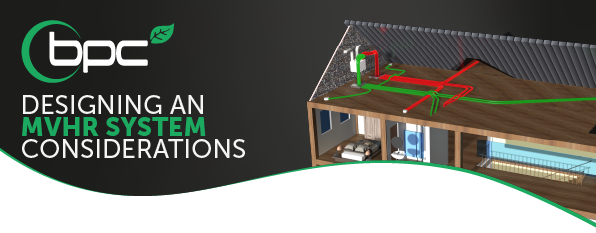How to approach designing ventilation into your build

These are now replacing conventional methods, such as trickle vents and individual extractor fans in moist areas like kitchens and bathrooms.
Mechanical Ventilation with Heat Recovery (MVHR), which works on an integrated basis with whole-house ventilation, is a way to provide a fresh supply of air in our homes that have been pre-warmed using recovered heat.
SO HOW DO I INCORPORATE A VENTILATION SYSTEM EFFECTIVELY
Correctly designing an MVHR system that integrates well within your new home is vital & should be considered as part of the initial design phase, if not some common problematic issues are listed below.
Services not considered in early design
Get your architect to think of services and duct routes right from the initial design stage. When it comes to the design of an MVHR system, this can have a major impact on how complex the ducting system is and even if one or two ventilation units are needed.
No Co-ordination with Structural Design
Structural beams are often an obstacle in the service zone of a building. It is advantageous to coordinate the structural design right from the start with all larger services, such as ventilation ducting. Sometimes it is necessary that services penetrate through beams.
MVHR Unit in Poorly Accessible Position
MVHR units need to be easily accessible for filter changes and maintenance. If they are positioned in loft spaces with no access path, it can become an adventure for occupants, as they balance over joists to avoid falling through the ceiling. Also, the specified service space around the MVHR unit needs to be maintained.
Not Enough Space for Manifolds & Silencers
Some of the ducting components need more space than others, e.g., air manifolds and silencers. The MVHR unit needs to be positioned in such spaces that these items fit into the ceiling or in other service areas. It is therefore important to incorporate the joist layout into the final design drawing.
Not Enough Details in the Initial Design Drawing.
MVHR design drawings with too little detail leave an open door for misinterpretation on site. Duct diameters, silencers, type of terminals and other components should always be shown and narrated, as well as their position within the structure. It is better to obtain & send a full set of project drawings to include floorplans, sections plus elevations.
No Regards for the Thermal Zone & Lack of Insulation.
If supply and extract ducts are positioned in spaces that are cold, the efficiency of the system will suffer. It is recommended to keep these fully within the thermal envelope, e.g., under 100% of the loft insulation. Otherwise, sufficient duct insulation needs to be applied; we recommend 100mm of duct wrap or similar. Intake ducts also need to be insulated if situated in a cold loft or eave space as these can heat up with solar gains thus eliminating the cooling effect of the summer bypass.
Too Long Intakes & Exhaust Ducts Within Warm Space.
Intake and exhaust ducts within the thermal envelope should be insulated with vapour proof
material and kept as short as possible. The recommendation for Passivhaus buildings is a max 1.5m each. Directional combination grilles help to keep these duct lengths short.
External Intake Close Above the Exhaust.
The position of the external intake and exhaust terminals can vary. Although 2m is mentioned in the BRE Digest 398 document, even at 500mm distance horizontally very little cross-contamination occurs in most cases. It should, however, be avoided to place the intake close above the exhaust as the exhaust air is slightly warmer than the surrounding atmosphere (especially in frosty weather) and will rise into the intake path.
Intake Exposed to Strong Winds or Pollution.
The external intake of the MVHR system should not be situated in elevations which are exposed to strong wind or pollution, e.g., gas flues or chimneys. For roof cowls, the prevailing wind direction should also be regarded to avoid contamination from flues or the MVHR exhaust.
Extract Terminal Away from Source of Humidity.
We often find that the extract valves in wet rooms are positioned close to the door and not near the shower or bath. Please always consider the ventilation path to avoid short-circuiting extract ventilation.
If the MVHR unit and the ducting system have been specified and designed correctly, this will guarantee that the systems will be compliant and efficient. It will give the homeowner the best possible indoor air quality.
Professional Design and Estimate Service
Our in-house experts can design and provide an estimate for you!

